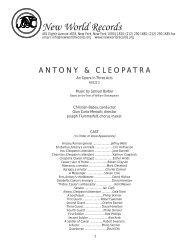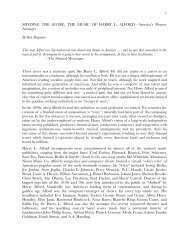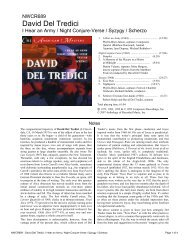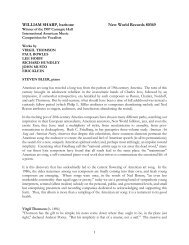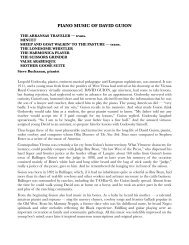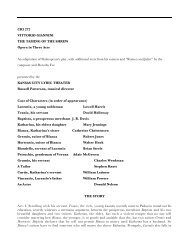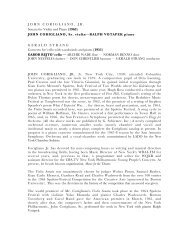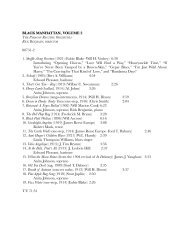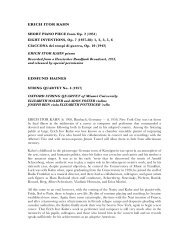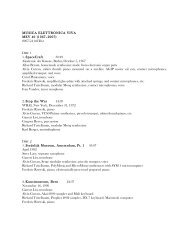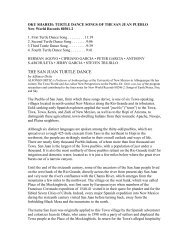MICHAEL TENZER 80697-2 1. Unstable Center - New World Records
MICHAEL TENZER 80697-2 1. Unstable Center - New World Records
MICHAEL TENZER 80697-2 1. Unstable Center - New World Records
Create successful ePaper yourself
Turn your PDF publications into a flip-book with our unique Google optimized e-Paper software.
<strong>MICHAEL</strong> <strong>TENZER</strong><br />
LET OTHERS NAME YOU<br />
<strong>80697</strong>-2<br />
<strong>1.</strong> <strong>Unstable</strong> <strong>Center</strong> (2003; Balinese title: Puser Belah [poo-sir b’LAH]) for double gamelan 19:26<br />
Premiered June 20, 2003 at the Bali Arts Festival, Denpasar, Bali, Indonesia.<br />
Genta Buana Sari group<br />
Wayan Juniarta, Nyoman Putra Lastana, kendang; Ketut Wirawan, cengceng; Pande Nyoman Budiana,<br />
kempli; Komang Putra, suling; Kadek Artika, Komang Widana, Madé Sukarda, Wayan Agus Satya Putra,<br />
pemadé; Wayan Kioana, Wayan Murtika, Nyoman Sukarta, Nicole Walker (Vancouver), kantilan; Jeff<br />
Purmort (U.S.), ugal; Madé Sudarna, Cok Alit Juliawan, Pande Putu Suardana, Leslie Tilley (Vancouver),<br />
reong; Gusti Ngurah Ketut Astana, Pande Madé Leo, penyacah; Putu Parmanta, Rich St. Onge<br />
(Vancouver), calung; Wayan Eka Pertama, Ketut Artana, jegogan; Nyoman Kantra, gong<br />
Sanggar Çudamani group<br />
Dewa Putu Rai, Michael Tenzer, kendang; Madé Suandiyasa, cengceng; I Madé Karjana kempli; I Komang<br />
Putra, suling; Dewa Madé Suparta, Dewa Putu Sudiantara, Madé Karmawan, Wayan Sudirana, pemadé;<br />
Dewa Ketut Alit Adnyana, Leo Pedersen (Vancouver), Madé Mahardika, Dewa Gdé Gunarta, kantilan;<br />
Dewa Madé Suardika, ugal; Gusti Nyoman Duarta, Colin MacDonald (Vancouver), Madé Sulaeman, Madé<br />
Pasta, reong; Eka Mardiana, Ketut Surya Tenaya, penyacah; Ida Bagus Putu Haridana, Kim Kobayashi<br />
(Vancouver), calung; Komang Wirawan, Gusti Putu Ratna, jegogan; Madé Widana, Putu Eka Saputra,<br />
Sutrisno (Vancouver), suling; Dewa Ketut Alit, rebab; Dewa Putu Cenik, gong<br />
2-3. Invention and Etude (2004) 10:29<br />
Naoko Christ-Kato, piano<br />
Premiered January 28, 2005 in Kiel, Germany, at Christian-Albrechts Universität.<br />
4. Underleaf (2006; Balinese title: Buk Katah [book ka-TAH]) for Balinese gamelan and a nonet of<br />
brass, winds, and piano 21:23<br />
Premiered July 10, 2006 at the Bali Arts Festival, Denpasar, Bali.<br />
Vancouver Players<br />
Francois Houle, A.K. Coope, clarinets; Colin MacDonald, Kristan Kuntz, saxophones; Malcolm Aiken,<br />
Rachel Lowry, trumpets; Rod Murray, François Levesque, trombones; Corey Hamm, electric piano
Sanggar Çudamani group<br />
Dewa Putu Rai, Dewa Putu Berata, Madé Mahardika, Michael Tenzer, kendang; Madé Suandiyasa,<br />
cengceng; Gusti Putu Ratna, kempli; I Komang Putra, suling; Dewa Madé Suparta, Dewa Putu Sudiantara,<br />
Madé Karmawan, Wayan Sudirana, pemadé; Dewa Ketut Alit Adnyana, Nicole Walker (Vancouver), Gusti<br />
Ngurah Suryana, Dewa Nyoman Apramada, kantilan; Dewa Madé Suardika, ugal; Gusti Nyoman Duarta,<br />
Ida Bagus Madé Widnyana, Kadek Armita, Leslie Tilley (Vancouver), reong; Madé Karjana, Madé<br />
Widana, penyacah; Ida Bagus Putu Haridana, Dewa Gdé Gunarta, calung; Madé Pasta, Dewa Putu<br />
Wardika, jegogan; Dewa Gedé Mega Putra, gong; Madé Suniantara, kempurKlentong<br />
5. Resolution (2007; Balinese title: Tabuh Gari [tah-boo ga-REE]) for small orchestra and Balinese<br />
drums. 13:14<br />
American Composers Orchestra commission; world premiere January 20, 2008 with Turning Point<br />
Ensemble at the Chan Centre, Vancouver, B.C.; U.S. premiere February 8, 2008 at Zankel Hall with<br />
American Composers Orchestra.<br />
OSSIA Ensemble: Luke Fitzpatrick, flute; Trevor Mowry, oboe; Chester Howard, clarinet; Eryn Bauer,<br />
bassoon; Lesie Hart, horn; William Osinski, trumpet; Erik Jacobs, trombone; Andy Smith, tuba; Matthew<br />
Witten, percussion; Lara Somogyi, harp; Liu Liu, piano; Kitty Cheung, Christina Zhou, Jenna Anderson,<br />
Jujin Chung, Yixuan Song, Sahran Kim, Aaron Yarmel, Ji Eun Park, Abby Swidler, Lucia Petito, Hyeri<br />
Choi, violins; Jennifer Turbes, Candy Amato, Jared Davis, Tina Wagner, Melissa Claisse, Andrew<br />
McManus, violas; Mariel Roberts, Ignacy Grzelazka, Taide Prieto Carpio, Andrew Barnhart, Rebecca<br />
Herman, cellos; Clint Sevcik, Billy Holten, double basses; Michael Tenzer, Balinese kendang wadon;<br />
Wayan Sudirana, Balinese kendang lanang; David Jacobs, conductor
In summer 2003, I went to Bali to visit my gamelan teacher, I Nyoman Suadin, in Kerambitan, northwest of<br />
Denpasar. Along the way, I stopped in the village of Peliatan, near Ubud, to meet up with Michael Tenzer,<br />
who was in Bali working with Çudamani, a large gamelan collective that rehearsed nearby. I had known<br />
Michael for years as a composer and scholar whose work on Balinese gamelan I greatly respected—and,<br />
over the years, we had become friends. Michael was in Bali to teach his new double gamelan piece, Puser<br />
Belah/<strong>Unstable</strong> <strong>Center</strong>, to the musicians of Çudamani. Çudamani is an unusually talented and energetic<br />
group of young men from all over the island. They are semi-professional (not common in Bali) and have<br />
positioned themselves to bridge between older, traditional Balinese musical forms and contemporary<br />
compositions. The players were augmented by another group, Genta Buana Sari. Michael, playing lead<br />
drum, and six of his students were seated among them too.<br />
I thought it would be fun to watch some of the rehearsals—sort of a reversal of my usual gamelan experience<br />
in the United States, where Balinese musicians teach us. Here, a Westerner was teaching them. So, I began<br />
to wonder, was there really an “us” and a “them?” And, if so, how would that play out in these rehearsals?<br />
Michael had rented a motorbike (the most common form of transportation in Bali), and in the early<br />
evening we hopped on and rode to the home of Dewa Putu Berata, Çudamani’s director.<br />
That first night Michael rehearsed a middle section, teaching it by rote in the Balinese way. It was a<br />
challenge; initially, the players could not grasp the differences in meter and tempo that the piece required<br />
and sometimes stopped playing in confusion, breaking off into gales of laughter as they fell over onto the<br />
floor. I was struck by how Michael and the group handled this: There was a wonderfully warm and<br />
supportive atmosphere, an acknowledgement that mistakes were being made, but that no one person or<br />
group was responsible and no harm was done. Then a magical moment occurred: they got it, and even<br />
more magically—they never lost it again. As Michael told me later:<br />
“This was a total pleasure: by the time they got it into their bodies, it was so solid that they<br />
knew it much better than I did. When they got it, it stuck to them like flypaper. . . . It’s so<br />
much fun learning music and doing music with that kind of spirit and friendliness and<br />
laughter.” (interview)<br />
That night and over the next three, I witnessed an extraordinary event: not merely the coming together of<br />
great musicians in a collective effort to learn a difficult piece of music, but also the very real possibility of<br />
true cross-cultural communication, the opening of a window of opportunity for deeply understanding<br />
musical and social difference.<br />
This collection of five pieces firmly situates composer and ethnomusicologist Michael Tenzer in the<br />
forefront of a group of contemporary composers creating cross-cultural musical and social fusions, while<br />
dealing openly with issues of cultural power and hegemony, and simply luxuriating in the sheer sounds of<br />
musics that are neither here nor there, but are from an altogether different place.<br />
The three large-scale works using gamelan instruments were conceived as a triptych. They are related<br />
structurally by their adaptation of the three-sectional form often found in large-scale Balinese compositions,<br />
collectively called lelambatan (“slow music”) that is generally performed at temples during religious festivals.<br />
Lelambatan contain three formal sections: 1) a multi-section introduction (kawitan, beginning) including<br />
several subsections, such as a free-rhythm passage in so-called gineman style, plus metered music and<br />
repeating brief cycles; 2) a pengawak (body), the most substantial section, performed in a slow, stately<br />
tempo; and 3) a pengecet (the foot of the piece, from the Balinese “to trot”), generally a faster and shorter<br />
cyclical section often involving interlocking parts. Sometimes a coda (pekaad) follows the pengecet to close<br />
the lelambatan form.
The gamelan as well as the two piano pieces are also related rhythmically by their use of the complex<br />
rhythmic play of the tani avarthanam, a long drum solo characteristic of South Indian classical music.<br />
Tenzer employs the korvai, a rhythmic composition that forms part of the tani avarthanam, in all of the<br />
pieces here, embedding it in each of the pengawak (center) sections. Thus, all of the pieces in this collection<br />
use the aesthetic sensibilities, musical structures, and compositional resources of Balinese and South Indian<br />
traditions, as well as Western art musics in varying combinations, each creating a beautifully integrated<br />
whole that, like the pixels of digital imaging, can been seen (when looking closely) as a collection of<br />
individual and bounded entities or (when stepping back) as a collective and seamless work of art.<br />
The music also makes nuanced and carefully differentiated statements about the possibilities of crosscultural<br />
communication and tolerance. Somewhat unresolved and exploratory in nature, yet ultimately<br />
hopeful in vision, together they explore musical and social arrangements that question basic assumptions<br />
about difference, tolerance, and about our ability to get along in a world largely defined today by tension<br />
and conflict.<br />
Puser Belah/<strong>Unstable</strong> <strong>Center</strong> (2003) was written as a response to the bombings that occurred in Bali on<br />
October 12, 2002 in Kuta, a popular beach area in the southern part of the island. The deadliest act of<br />
terrorism in Indonesia’s history, the bombings took 202 lives, many of them Australian and American<br />
tourists (the apparent target of this attack), but also 38 Indonesians who were working in the area, or simply<br />
walking by when the three bombs went off. This had a devastating effect on the Balinese, emotionally and<br />
economically. Tenzer, who has lived for long periods in Bali, and has developed lasting friendships there,<br />
wanted to respond somehow to this tragic event.<br />
The Balinese words Puser Belah literally mean “split navel,” navel being a common Balinese metaphor that<br />
positions Bali as the “navel” of the world, “the center and focus of contemplation” (e-mail, May 8, 2009).<br />
The piece was written for two separate and equal entities, each symbolized by a gamelan semaradana, a<br />
Balinese gamelan (ensemble of instruments) developed in the 1980s by the renowned Balinese composer<br />
and instrument maker I Wayan Berata. Using the full resources of the seven-tone pelog scale (McPhee,<br />
1966 and Tenzer, 1992), it is more flexible tonally and orchestrally than other ensembles on the island, and<br />
has been a focus of compositional innovation in the years since its introduction. According to the program<br />
notes, which were read aloud in both English and Indonesian at the 2003 Bali Arts Festival premiere:<br />
At first, [each of the two ensembles] behaves without any consciousness of the other also<br />
inhabiting its world. Little by little, they become aware of each other. At the root of their<br />
interaction are elements of both cooperation and conflict. Just after the mid-point they are,<br />
at last, truly able to play together. But, subsequently, because of the difficulty and challenge<br />
of attaining and preserving a lasting peace, their relationship comes to a kind of explosive<br />
end. In the closing section, the elements of conflict return and remain dominant. The<br />
narrative raises the profound question of whether two different cultures are able to live<br />
together peacefully.<br />
Each section of the piece is characterized by a different interaction between the two ensembles, framed in<br />
large part by different tempi, rhythmic structures, and contrasting melodic material. At first (0:00-2:30), the<br />
two gamelan, seemingly unaware of each other, play freely, one group stating a series of irregularly spaced<br />
chords, the other a slowly expanding melody. When the four drums (divided between the two groups) first<br />
enter (2:33), they do so tentatively, like harbingers of consciousness, anticipations of possible group-ness to<br />
come. The drums are the signal that awakens the two groups to each other; their growing control and<br />
complexity act to anchor the two groups and orient them toward each other.
Near the middle section, as the two gamelan attempt to find a peaceful solution to their differences, conflicts<br />
continue to arise in the form of many stops and starts, reong (pot gongs) flourishes (6:23, 6:39), rapid<br />
interlocking melodies (8:08-9:40), and long intense pauses (12:15 and elsewhere). The rise and fall of the<br />
melodic material here, although controlled somewhat by a long korvai rhythm (12:18-13:33 and repeated at<br />
13:33-14:48), swings the groups back and forth on a pendulum between conflict and reconciliation.<br />
Eventually, an explosion results (15:05-15:25) and, after many attempts to come together again, conflict<br />
continues (17:05).<br />
Near the end, Tenzer gives the following direction in the score: “the two gong players get up, walk to the<br />
front of the stage, and stand facing each other with their large gong mallets held before them, arms<br />
outstretched.” This theatrical gesture, from a Balinese perspective, signals ultimate failure; if the gong—the<br />
center of the universe—fails, there is no hope. “Sometimes everything looks great, sometimes it seems<br />
hopeless. No matter how much time we devote to getting to know each other, there is always going to be the<br />
power imbalance, there are always going to be fundamental differences in worldview that we can never really<br />
get beyond. I despair about that, sometimes.” (interview)<br />
After finishing Puser Belah, Tenzer took stock. He began to think of other ways in which Balinese, Indian,<br />
and Western musical sounds, structures, and sensibilities could be combined. He turned to two Western<br />
classical forms traditionally used to work through and carefully study new musical structures. Invention and<br />
Etude (2004) became his laboratory. “I thought I should have a practice session in which I would work it<br />
out—but not on the gamelan. The piano pieces were a kind of laboratory for developing the way I was<br />
thinking.”<br />
In Invention and Etude, Tenzer experiments with the multifaceted rhythmic complexities of the tani<br />
avarthanam, the long drum solo that occurs near the end of a South Indian classical concert. The drum<br />
solo usually starts somewhere in the middle of the concert’s most extended selection, leaving it suspended,<br />
and may last for many minutes. The tani avarthanam can contain freely composed parts, where the<br />
drummer improvises (and displays his virtuosity), but also must include at least one korvai. The trick is for<br />
the drummer to calculate in advance how to fit a variety of irregular korvai patterns over how many talas<br />
(metric cycles that underlie Indian music) and re-enter at the eddupu, the precise place where the singer or<br />
player stopped.<br />
As part of their training, South Indian drummers learn many korvais, and how they fit best with specific<br />
talas, so that in a performance, while they are instantaneously calculating their length, they can also rely on<br />
their extensive knowledge of these compositions to help them enter at the right instant. Tenzer had studied<br />
South Indian drumming with N. Govindarajan in Madras in 1988-89, included korvai in some of his earlier<br />
gamelan music (heard on American Works for Balinese Gamelan, <strong>New</strong> <strong>World</strong> CD 80430-2), and adapted<br />
these forms in his piano pieces, wanting to “work out how to fuse ideas of Indian rhythms and [Western]<br />
harmonies, where changing harmonies are lined up with the drum rhythms.”<br />
In Invention, he explores this in a long korvai, by systematically increasing the density of the rhythm, thus<br />
shifting the major accents of the pattern and giving the impression that time is shrinking and accelerating as<br />
the pattern moves to cadence. The piece is structured on a segment of music that is 360 pulses long. As it<br />
progresses the 360 pulses are grouped first in threes, then fours, and then fives, (1:53, 2:42) creating a<br />
growing complexity that seems to push the rhythms inexorably to the eddupu. The harmonies, quite gentle<br />
at first, gradually intensify too. Etude, the “study piece,” is structured as a full tani avarthanam, containing<br />
korvais (2:56, 3:53, 4:51) that line up with different scalar-melodic patterns, creating rhythms and sonorities<br />
that are both Indian and Western.
After completing Invention and Etude, Tenzer returned to the original triptych project and to the gamelan.<br />
The result was Buk Katah/Underleaf, completed in 2006, and realized in Bali, again with Çudamani. A film<br />
documenting this project, Bali by Heart (2007), was later produced by Red Letter Films and shown on<br />
French TV5 and at several international documentary festivals. Buk Katah is scored for one gamelan<br />
semaradana and a nonet of Western classical instruments, forming a separate, embedded ensemble of<br />
winds and brass: two clarinets, two saxophones, two trumpets, two trombones, plus piano. Alternating<br />
between military-like, dance-band-ish, and jazzy passages, this ensemble provides a beautiful harmonic<br />
contrast to the texture of the gamelan in a quasi–concerto grosso style.<br />
Here, the ensembles represent two separate, unequal, and very different entities; the shared issues of<br />
reconciliation and negotiation are (almost) completely absent. Instead, the autonomy of the ensembles is<br />
highlighted: Each has a separate tuning system, sonority, and different melodic material, as though the<br />
composer has said, Okay—let them live in blissful difference. There is some coming together in spots, but<br />
merely to say hello and move on. Throughout, “all the instruments do what they’re born to do; they don’t<br />
sacrifice any of the richness of their own cultural traditions, but they also meld and become one ‘other<br />
thing.’ (Interview).” The title (as well as the title of this CD) is taken from a line of poetry in Ginada Basur, a<br />
song learned by Balinese children:<br />
“Don’t judge yourself able<br />
Let others name you<br />
Our work is to sweep<br />
Each day the dead leaves fall<br />
Remove them and the dust remains (buk katah)<br />
And in this way<br />
There will always be more to learn.” (e-mail communication, May 8)<br />
The dual nature of this composition was additionally highlighted by the presence of a group of twelve<br />
Canadians whom Tenzer brought with him to perform the piece at the 2006 Bali Arts Festival. Nine of<br />
these musicians formed the core of the smaller ensemble, while three (including Tenzer) performed with<br />
the gamelan. Over a month of daily rehearsals, the Western musicians read from a score; the Balinese<br />
learned, memorized, and performed in the traditional way—without notation.<br />
Again, Tenzer uses both the Balinese three-part structure of lelambatan and the Indian metric korvai<br />
structure, which begins in the pengawak (9:07-11:25 and repeated at 11:25-13:43). The pengecet (13:43-<br />
1952) is composed of a series of seven variations, with some of the variations sub-divided into variations of<br />
their own. Each is one gong cycle long, but the cycles vary in terms of their composite beats, so that not all<br />
of the variations are of the same length; and, each explores different harmonies, scales, and instrument<br />
combinations. A recapitulation of the opening cycle and a cadence (19:52-20:28) form the beginning of a<br />
pekaad, or closing section.<br />
Tabu Gari/Resolution (2008) is the final piece in this triptych, its Balinese title signifying a recessional piece.<br />
Its English title, however, is somewhat more cryptic: Does this piece resolve the musical and social tensions<br />
posed by Tenzer in the other pieces, or is it a resolution to do something? The composer gives us a musical<br />
clue: the piece is scored for small Western orchestra and two Balinese drums. It may seem on the surface<br />
that since most of the sonic material is that of a characteristic twentieth-century Western orchestral piece<br />
that he is saying, no resolution is in sight, and Western hegemony prevails.
From a Balinese perspective however, the title takes on a somewhat different meaning. In Bali, the drums<br />
and drummers are the leaders of the group; they provide all of the tempo, dynamic, sectional, and other<br />
cues for the rest of the players—in short, they act as conductors, leading the music on its path. In this piece,<br />
they seem to be quietly pulling the orchestra along, not only on its musical path, but also on its path to<br />
becoming all it can be. They are not asserting control here, but are rather gently leading the orchestra, with<br />
its “signature twentieth-century techniques,” and allowing it to exist “on its own terms.” (e-mail, April 20). As<br />
in Puser Belah, the drums are showing the way—in the first piece to consciousness and here, to resolution.<br />
The form of this piece, like the others in the collection, follows that of the Balinese lelambatan repertoire: a<br />
kawitan in two parts (0:00-4:33, 4:33-6:16); a pengawak, rhythmically structured by a korvai (6:16-9:16); and<br />
a pengecet: (10:32-end), consisting of an introduction, three variations---each featuring a different family of<br />
instruments---and finally, a pekaad, or coda.<br />
Obviously, the main theme that runs throughout this collection of pieces is one of reconciliation—<br />
negotiating just enough (but not all possible) differences for the sake of preserving both the integrity of<br />
individuals and the cohesiveness of community. Tenzer, through his intention in writing these pieces for<br />
Balinese and Western ensembles; through his teaching process, where he honored both Balinese and<br />
Western styles and integrated Balinese and Canadian/American performers; through his acknowledgement<br />
of the physical and emotional bonds between musicians; and, through his honest respect, deep knowledge<br />
and love for his two musical cultures, he has given us a rare present, one that both delights and asks<br />
important questions of its listeners.<br />
—Ellen Koskoff<br />
Ellen Koskoff is Professor of Ethnomusicology at the University of Rochester’s Eastman School of Music<br />
and director of the School’s Balinese gamelan angklung, Lila Muni. She has published widely on Jewish<br />
music and on gender and music, and is the author of Music in Lubavitcher Life (2000), winner of the 2002<br />
ASCAP Deems-Taylor award. Koskoff is the general editor of the Garland Encyclopedia of <strong>World</strong> Music,<br />
vol. 3, “The United States and Canada,” and has served as a former President of the Society for<br />
Ethnomusicology.<br />
Michael Tenzer’s activities encompass performance, composition, research, writing, and teaching. Born<br />
in <strong>New</strong> York City in 1957, he taught at Yale from 1986-96 and since then has been Professor of Music at<br />
the University of British Columbia in Vancouver. Tenzer’s compositions have been commissioned and<br />
performed in North America, Europe, and Asia, with the Brooklyn Philharmonic, the American<br />
Composers Orchestra, Turning Point Ensemble, Pandit Swapan Chaudhuri (tabla), Jane Coop (piano),<br />
Alex Klein (oboe) and Evan Ziporyn (clarinet). Recordings are available on <strong>New</strong> <strong>World</strong>, Cantaloupe, and<br />
Bali Stereo labels. He was the first non-Balinese ever to compose music performed by Balinese gamelan in<br />
Bali and has regularly produced influential compositions there since 1982. His works are cited by Balinese<br />
critics as “an important and unique contribution to our cultural heritage.” Tenzer’s writings include three<br />
books and numerous articles, ranging from detailed studies of Balinese music to consideration of European<br />
art music’s interaction with world music, the future of musical fusion, and world music theory. (See<br />
www.michaeltenzer.com; email mtenzer@interchange.ubc.ca.)
Sanggar Çudamani was founded in September 1997 in Pengosekan village, Bali, at the family compound<br />
of brothers Dewa Putu Berata (Director) and Dewa Ketut Alit (Artistic Director) as a professional company<br />
with a working philosophy much like a Balinese family temple or village collective. Its core membership of<br />
virtuoso musicians and dancers from numerous villages see themselves as a community of leaders who,<br />
through their music and dance, contribute to the artistic, cultural, and political life of their own villages.<br />
Çudamani works to achieve a balance of being active creative artists while also preserving ancient and rare<br />
repertoire. They have traveled to the United States (2002, 2005, 2007), Greece, Japan, and other festivals<br />
the world over, and as educators offer an International Summer Music and Dance Program every July.<br />
www.cudamani.org.<br />
Sekaha Gong Genta Buana Sari was founded in 1992 by Ir. A.A. Gede Oka Dalem at Puri Kaleran,<br />
Peliatan, Bali, to give young Balinese musicians opportunities to perform on a regular basis for a variety of<br />
events. These include presenting performances at Balerung Stage in Peliatan every Tuesday evening, as well<br />
as performing for state ceremonies, religious festivals, commercial events, and social gatherings when<br />
requested.<br />
OSSIA is a student-run new-music ensemble at the Eastman School of Music in Rochester, <strong>New</strong> York.<br />
OSSIA’s goal is to perform works which might not receive high-quality performances otherwise due to<br />
content, medium, or composer. Since its inception in 1996, OSSIA has premiered more than 80 pieces,<br />
recorded three CDs, and hosted many composers such as Chinary Ung, Chen Yi, Michael Tenzer, Helmut<br />
Lachenmann, and Steve Reich. In 2007 OSSIA initiated an International Composition Prize that<br />
immediately gained global attention. OSSIA’s concerts are produced by a board that is made up of students<br />
from nearly every department at Eastman and the programs are chosen from proposals made by members<br />
of the Rochester community. For more information about the OSSIA <strong>New</strong> Music organization, please visit<br />
www.Ossia<strong>New</strong>Music.org.<br />
Naoko Christ-Kato was born in Yokohama (Japan). She studied piano at the Tokyo College of Music<br />
(BA, 20000) and continued with Konrad Meister in Hannover (Germany) and Manfred Fock<br />
(Musikhochschule Lübeck, (AKA, Konzertexamen 2006). She has a special interest in romantic repertoire<br />
and contemporary music. She regularly collaborates in Lieder recitals with singer Gertrud Ottenthal.<br />
Wayan Sudirana was born in Ubud, Bali, in 1980. He is a graduate of the ISI Balinese Arts Institute and<br />
a member of the Çudamani collective. He is one of Bali’s most gifted young musicians, has composed and<br />
taught actively all over the island, and toured abroad frequently. He has been director of Gamelan Gita<br />
Asmara in Vancouver since 2004.<br />
David Jacobs is pursuing his Doctor of Musical Arts degree in Instrumental Conducting at the Eastman<br />
School of Music, where he is the recipient of the Frederick Fennell Fellowship for Advanced Conducting<br />
Study. He serves as the Assistant Conductor of the world-renowned Eastman Wind Ensemble. He is a<br />
fervent supporter of new music and has collaborated with noteworthy composers including Chen Yi,<br />
Michael Tenzer, and David Maslanka. Last year, he was one of three conductors selected from a national<br />
search for the Young Conductor Mentor Project where he worked closely with conductors and composers,<br />
aimed at bridging the gap between the creation of music and its interpretation.
SELECTED DISCOGRAPHY<br />
American Works for Balinese Gamelan. <strong>New</strong> <strong>World</strong> <strong>Records</strong> 80430-2.<br />
Three Island Duets. Included on This is Not a Clarinet. Evan Ziporyn, clarinet. Cantaloupe <strong>Records</strong> CD<br />
21002.<br />
SELECTED BIBLIOGRAPHY<br />
McPhee, Colin. Music in Bali. <strong>New</strong> Haven: Yale University Press, 1966.<br />
Morris, Robert. “Crowns: Rhythmic Cadences in South Indian Music.” Unpublished paper.<br />
Nelson, David Paul. Mrdangam Mind: The Tani Avartanam in Karnatak Music. Unpublished Ph. D.<br />
dissertation, Wesleyan University, 199<strong>1.</strong><br />
Tenzer, Michael. Gamelan Gong Kebyar: The Art of Twentieth-Century Balinese Music. Chicago:<br />
University of Chicago Press, 2000.<br />
——. Balinese Music. Berkeley: Periplus Editions, 1998 [1992].<br />
The Bali Arts Festival Performance of <strong>Unstable</strong> <strong>Center</strong> is on YouTube in 2 parts (search under Puser<br />
Belah). Underleaf’s 2006 Bali performance is also on YouTube, in 3 parts (search Buk Katah). Bali By<br />
Heart (Sylvia L’Ecuyer, director), a 60-minute documentary film about the making of Underleaf, is available<br />
at amazon.ca or www.redletterfilms.com. Contact the composer directly for scores and further information.<br />
Producer: Michael Tenzer<br />
Digital mastering: Paul Zinman, SoundByte Productions Inc., NYC<br />
<strong>Unstable</strong> <strong>Center</strong> was recorded June 19, 2003 by Kenneth <strong>New</strong>by in Pengosekan, Bali.<br />
Invention and Etude was recorded February 22, 2005 by Manfred Fock in the Kammermusikaal<br />
Musikhochschule, Lübeck, Germany.<br />
Underleaf was recorded July 9, 2006 by Natasha Fabijancic in Pengosekan, Bali. Recording mixed and<br />
mastered by François Houle, Vancouver, in Fall 2006.<br />
Resolution was recorded on October 25, 2008 by Matthew D. Guarnere, Blackdog Recording Studios, at<br />
the Eastman School of Music, Rochester, <strong>New</strong> York. Mixed and mastered by David Simpson in<br />
Vancouver, November 2008.<br />
Cover image: Hanoman, monkey-god of the Ramayana epic, overseer of monkey armies, and engineer of<br />
collaborative works<br />
Design: Bob Defrin Design, Inc., NYC<br />
This recording was made possible by a grant from the Francis Goelet Charitable Lead<br />
Trust.<br />
Thanks to The Hampton Fund and the Office of the Associate Vice-President for Research, University of<br />
British Columbia; Social Science and Humanities Research Council, Canada; Sanggar Cudamani,<br />
Pengosekan, Bali; Gamelan Gita Asmara, Vancouver; the Chan <strong>Center</strong>, Vancouver; Turning Point<br />
Ensemble; American Composers Orchestra; OSSIA; TV5 Quebec; Sylvie Peltier and Red Letter Films;<br />
Jeremy Berkman, Sylvia L’Ecuyer, Denis Grenier, Ellen Koskoff, Robert Morris, Wayan Rai, Baljinder<br />
Sekhon, Bapak Madé Sija, Gusti Ayu Srinatih, Maisie Sum, Owen Underhill; to Evan Ziporyn for<br />
innovating this kind of composing, and to Patty Hoy and Eric Wilson for unwittingly giving me the idea for<br />
this project in 200<strong>1.</strong>
FOR NEW WORLD RECORDS:<br />
Herman E. Krawitz, President; Lisa Kahlden, Vice-President; Paul M. Tai, Director of Artists and<br />
Repertory; Mojisola Oké, Bookkeeper; Anthony DiGregorio, Production Associate.<br />
ANTHOLOGY OF RECORDED MUSIC, INC., BOARD OF TRUSTEES:<br />
Richard Aspinwall; Milton Babbitt; Amy Beal; Thomas Teige Carroll; Robert Clarida; Emanuel Gerard;<br />
David Hamilton; Rita Hauser; Lisa Kahlden; Herman E. Krawitz; Fred Lerdahl; Robert Marx; Elizabeth<br />
Ostrow; Cynthia Parker; Larry Polansky; Don Roberts; Patrick Smith; Paul M. Tai; Blair Weille.<br />
Francis Goelet (1926–1998), Chairman<br />
For a complete catalog, including liner notes, visit our Web site: www.newworldrecords.org.<br />
<strong>New</strong> <strong>World</strong> <strong>Records</strong>, 75 Broad Street, Suite 2400, <strong>New</strong> York, NY 10004-2415<br />
Tel (212) 290-1680 Fax (212) 290-1685<br />
E-mail: info@newworldrecords.org<br />
P & © 2009 Anthology of Recorded Music, Inc. All rights reserved. Printed in U.S.A.<br />
All compositions published by Bridge of Monkeys Music (ASCAP).<br />
NO PART OF THIS RECORDING MAY BE COPIED OR REPRODUCED WITHOUT<br />
WRITTEN PERMISSION OF A.R.M., INC.



